| Round Top Mountain | |
|---|---|
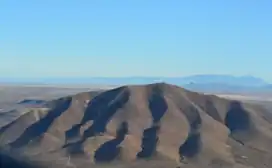 Aerial view of Round Top Mountain in Texas | |
| Highest point | |
| Elevation | 5,732 ft (1,747 m)[1] |
| Coordinates | Texas location map.svg_scale:100000 31°16′36″N 105°28′27″W / 31.276644°N 105.474243°W |
| Geography | |
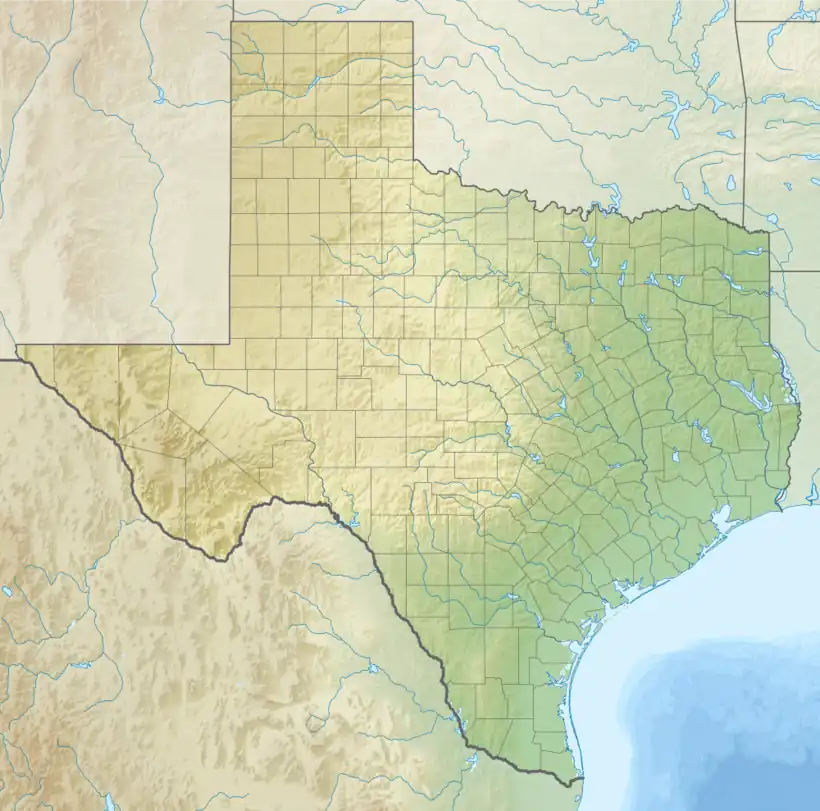 Round Top Mountain Hudspeth County, Texas, United States | |
| Topo map | USGS Round Top Mountain[2] |
Round Top Mountain is a mountain located at the western end of the Sierra Blanca area in Hudspeth County, Texas near the town of Sierra Blanca. The area includes the Finlay Mountains, Triple Hill, and Sierra Blanca quadrangles as well as parts of the Fort Quitman and McNary quadrangles.[3][4] Round Top Mountain is known for containing deposits of beryllium as well as the largest deposit of heavy rare-earth elements in the United States.[5]
Geography
Round Top Mountain is located in the Trans-Pecos region of West Texas, northeast from the Mexican border.[6][7] The region is the most mountainous area of Texas, and lies to the southeast of the Sierra Blanca mountain range. The area includes the Finlay Mountains, Triple Hill, and Sierra Blanca quadrangles as well as parts of the Fort Quitman and McNary quadrangles.[4] The Sierra Blanca area is approximately 950 square miles (2,500 km2). Round Top Mountain is one of five peaks made from laccoliths in the area, with the others being Little Round Top, Little Blanca, Triple Hill, and Sierra Blanca.[4] The area lies between the northern Quitman Mountains and Devils Ridge.[8]
The closest town to Round Top Mountain is Sierra Blanca, Texas, located 8 miles (13 km) southeast of the mountain with a population of approximately 553 people.[7] It is accessible by Interstate 10 and approximately 85 miles (137 km) east of El Paso, Texas.[9]
Round Top Mountain is more than a mile in diameter at its base (approximately 1,609 meters). Its peak is 1,000 feet (300 m) above the desert plateau and approximately 4,270 to 4,600 feet (1,300 to 1,400 m) above sea level.[3]
Geology
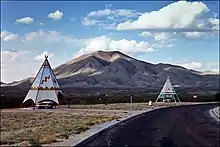
The Sierra Blanca area is on the northern margin of the Chihuahua Tectonic Belt and is a massive complex of volcanic rocks including pyroclastic materials, lava flows, and intrusions.[8] Round Top Mountain is a surface-exposed rhyolite intrusion that was created from molten liquid rock pushing up from beneath the earth's surface.[5] The top layer of sedimentary rock that makes up the mountain has been eroded over time, exposing the rhyolite formation. It also contains quantities of Del Rio Clay and Finlay limestone[3] as well as deposits of uranium and lithium.[10][11] The area contains scrub brush and grasses that are supported by the mountain's sandy loams and clay.[1]
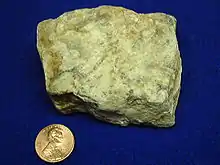
The first geological exploration in the area of Round Top Mountain was in the 1970s when fluoride deposits were discovered.[3] Holes were drilled along with prospective trenches in Round Top Mountain, Little Blanca Mountain, and Little Round Top Mountain between 1971 and 1980.[12] The 1980s led to the discovery of deposits of beryllium that are concentrated on the northwest corner of Round Top Mountain.[13] Throughout the 1980s, several companies held interest in the mountain, including the Cabot Corporation and the Cypus Metals Company.[12] A 1988 feasibility study found the mountain to contain approximately 298,000 tons of ore with a prediction of yielding 11,000,000 lbs of beryllium.[12]
Round Top is known for containing rare-earth elements, including the largest deposit of heavy rare-earth elements in the United States, estimated at over 1 billion tons.[5] The rare-earth elements contained in the mountain can be used to build energy and defense applications as well as electronic devices, lasers, in oil and gas drilling, water treatment, and other uses.[11] The deposit in the mountain includes five light and 10 heavy rare-earth elements.[11] The heavy rare-earth mineralization at Round Top is unique, with these elements hosted in yttrofluorite, a variety of the mineral fluorite.[14] No similar deposit has been described elsewhere.[14]
Round Top Project
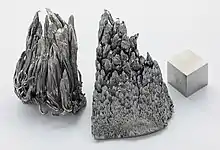
The Round Top Project is a joint venture of USA Rare Earth and Texas Mineral Resources Corporation (TMRC; formerly Texas Rare Earth Resources).[15] Round Top hosts 16 of the 17 rare earths, as well as industrial minerals including lithium, beryllium, and uranium. In addition to the rare earths and scandium, the Round Top project contains 11 of the 35 non-rare earth minerals deemed "critical to U.S. national security and the economy" by the U.S. Department of the Interior.
While the site is owned by the Texas General Land Office, it was leased to Texas Rare Earth Resources beginning in May 2011 for the exploration and development of the site's rare-earth elements.[15] The United States was the leading producer of rare-earth elements until the 1990s when lower production costs in China caused other mines to close down. China began restricting exports of rare-earth elements in 2006, causing a substantial rise in the cost of the elements.[15] China's monopoly on these elements led to the exploration for rare-earth elements in the United States, including opening of previously closed mines.[15]
The Round Top Project began in the 1980s with the drilling of several locations in the mountain for fluoride and later beryllium. The project was originally for the exploration and development of beryllium and uranium, both of which are found in the mountain.[16] Texas Rare Earth Resources picked up the project in 2011 with the re-logging and re-analyzing of the previous 82,000 feet (approximately 24,993 meters) of drilling. A 1990 study by the Texas Bureau of Geology estimated the rare-earth deposits in the mountain to be 1.6 billion metric tonnes.[3] The Round Top Project plans to extract the heavy rare-earth elements through an open-pit mine, crushing the ore and using a heap leaching process to extract the elements.[17] The project cost is approximately $290 million with an estimated $8 billion in projected revenue over 20 years of mining.[11]
The heavy rare-earth elements are hosted in yttrofluorite which is soluble in dilute sulfuric acid, making heap leach extraction feasible.[18] The natural porosity and permeability of the rhyolite provide the micro-conduits that allow the acid to penetrate to the interior of the large crush size (one inch, or 2.5 cm) for the heap leach.[18] The even grade of heavy rare-earth mineralization throughout the deposit leads to a consistent, unchanging quality of raw material for the heap leach.[14]
Defense Logistics Agency Grant Project
In September 2015, the U.S. Department of Defense, through the Defense Logistics Agency (DLA), awarded TMRC a Broad Agency Announcement (BAA) research contract. In July 2016 TMRC announced it had successfully completed a demonstration-of-concept project using Round Top ore as feedstock to separate and refine specific high-purity rare earth elements for the DLA Strategic Materials Division in conjunction with its joint venture partner K-Technologies, Inc. (K-Tech). In the bench scale demonstration, Texas Mineral Resources Corp. and K-Tech successfully separated specified high-value rare earths to between 99.996 and 99.999% purity, using static column systems designed to provide the general design concepts for ultimate use of continuous ion exchange (CIX) and continuous ion chromatography (CIC) systems at larger scales.
Expanded Preliminary Economic Assessment
TMRC and its funding and development partner USA Rare Earth, LLC announced completion of an expanded and updated NI 43-101 Preliminary Economic Assessment (PEA) on the Round Top Project on August 20, 2019.[19]
The PEA reports a Net Present Value (NPV) for the project of $1.56 Billion (at a 10% discount rate, pre-tax), an Internal Rate of Return (IRR) of 70%, and a Payback Period of 1.4 years. Capital Cost for the project is $350.4 Million, including a complete on-site rare earth oxide and mineral separation plant, and includes a 25% contingency provision of $65.7 Million.
Environment
Ground water near Round Top Mountain is available through natural underground reservoirs. However, the water is too brackish and mineral-laden to be potable.[17] The rainfall in the area comes primarily from thunderstorms during the months of July and August, with the months of January through April being mostly dry.[5] Temperatures during the summer months reach 100 °F during the day with cooler temperatures at night. Due to the breezes in the higher parts of the mountain the actual temperature can vary considerably in the area.[5] Round Top Mountain is a low impact for earthquakes with approximately one occurrence every 50 years.[20]
Climate
| Climate data for Round Top Mountain (Sierra Blanca, Texas) | |||||||||||||
|---|---|---|---|---|---|---|---|---|---|---|---|---|---|
| Month | Jan | Feb | Mar | Apr | May | Jun | Jul | Aug | Sep | Oct | Nov | Dec | Year |
| Mean daily maximum °F (°C) | 58 (14) |
63 (17) |
69 (21) |
78 (26) |
87 (31) |
94 (34) |
92 (33) |
90 (32) |
87 (31) |
78 (26) |
67 (19) |
58 (14) |
77 (25) |
| Mean daily minimum °F (°C) | 26 (−3) |
29 (−2) |
35 (2) |
43 (6) |
52 (11) |
61 (16) |
64 (18) |
62 (17) |
56 (13) |
44 (7) |
33 (1) |
26 (−3) |
44 (7) |
| Average precipitation inches (mm) | 0.40 (10) |
0.68 (17) |
0.30 (7.6) |
0.33 (8.4) |
0.52 (13) |
1.13 (29) |
2.13 (54) |
2.15 (55) |
1.45 (37) |
1.15 (29) |
0.41 (10) |
0 (0) |
11.27 (286) |
| Source: [21] | |||||||||||||
See also
References
- 1 2 "Sierra Blanca". TSHA online. 2010-06-15. Retrieved 23 February 2015.
- ↑ "Feature Detail Report for Round Top Mountain". USGS. Retrieved 3 March 2015.
- 1 2 3 4 5 Hatch, Gareth (19 May 2014). "A Visit To The Texas Rare Earth Resources Round Top Project". Tech Metal Research. Retrieved 20 February 2015.
- 1 2 3 Quintana, Amed Gomez (2013). Rare earth element geochemistry of the Sierra Blanca laccoliths, Texas (MS thesis). University of Texas at El Paso. ProQuest 1501648821. Retrieved 3 March 2015.
- 1 2 3 4 5 Pingitore, Nicholas; Clague, Juan; Gorski, Daniel (January 2014). "Round Top Mountain rhyolite (Texas, USA), a massive, unique Y-bearing-fluorite-hosted heavy rare earth element (HREE) deposit". Journal of Rare Earths. 32 (1): 90–96. doi:10.1016/S1002-0721(14)60037-5.
- ↑ Stein, Holly J.; Hannah, Judith L. (1990). Ore-bearing Granite Systems: Petrogenesis and Mineralizing Processes. Geological Society of America. ISBN 9780813722467.
- 1 2 "Sierra Blanca, Texas". City Data. Retrieved 23 February 2015.
- 1 2 McAnulty, W. N. (1980). "Geology and Mineralization of the Sierra Blanca Peaks". New Mexico Geological Society Guidebook.
- ↑ Bloom, Steve (14 October 2012). "Welcome to Sierra Blanca Texas - The Black Hole of Tour Bus Drug Busts". The Hollywood Reporter. Retrieved 23 February 2015.
- ↑ Price, Jonathan G.; Rubin, Jeffrey N.; Henry, Christopher D. (1990). "Rare-metal enriched peraluminous rhyolites in a continental arc, Sierra Blanca area, Tans-Pecos Texas". Geological Society of America (1). doi:10.1130/SPE246-p103.
- 1 2 3 4 Kolenc, Vic (26 January 2014). "$8 billion worth of rare-earth minerals in Sierra Blanca area mountain, company says". Elpaso Times. Retrieved 20 February 2015.
- 1 2 3 "Project Development Program Sierra Blanca Beryllium Project". Cyprus Sierra Blanca, Inc. March 1988.
- ↑ "The Ellis Martin Report with Marc LeVier". Ellis Martin Report. 29 August 2011. Retrieved 20 February 2015.
- 1 2 3 Pingitore, N. E.; J. W. Claugue (2014). "Uniform Distribution of Yttrium and Heavy Rare Earth Elements in Round Top Mountain Rhyolite Deposit, Sierre Blanca Texas, Data, Significance, and Origin". American Geophysical Union, Fall Meeting. 2014. Bibcode:2014AGUFM.V23D4827P.
- 1 2 3 4 Berger, Eric (14 March 2012). "The great global hunt for rare Earth metals comes to Texas". Houston Chronicle. Retrieved 20 February 2015.
- ↑ Fulp, Mickey (29 August 2011). "Every Good Geologist Knows Grade is King". Resource Investor. Retrieved 20 February 2015.
- 1 2 "TRER Details New Plan for Round Top Mine". Hudspeth County Herald. 27 December 2013. Retrieved 20 February 2015.
- 1 2 Negron, L. M.; J. W. Claugue; D. Gorski; M. A. Amaya; N. E. Pingitore (2013). "Fluorescein Dye Penetration in Round Top Rhyolite (Hudspeth County, Texas, USA) to Reveal Micro-permeability and Optimize Grain Size for Heavy REE Heap Leach". American Geophysical Union, Fall Meeting. 2013. Bibcode:2013AGUFMMR13A2271N.
- ↑ http://www.tmrcorp.com/_resources/reports/TMRC-NI43-101-PEA-2019-16-August-2019.pdf
- ↑ "Round Top Mountain". Chinci. Retrieved 20 February 2015.
- ↑ "Sierra Blanca, TX Weather". Weather.com. Retrieved 19 February 2015.